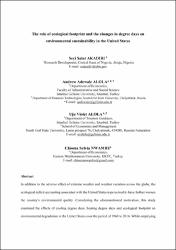| dc.contributor.author | Saint Akadiri, Seyi | |
| dc.contributor.author | Alola, Andrew Adewale | |
| dc.contributor.author | Alola, Uju Violet | |
| dc.contributor.author | Nwambe, Chioma Sylvia | |
| dc.date.accessioned | 2020-05-16T21:45:14Z | |
| dc.date.available | 2020-05-16T21:45:14Z | |
| dc.date.issued | 2020 | en_US |
| dc.identifier.issn | 0944-1344 | |
| dc.identifier.issn | 1614-7499 | |
| dc.identifier.uri | https://hdl.handle.net/11363/2139 | |
| dc.description | Document Information
Language: English
Accession Number: WOS:000528986800002
PubMed ID: 3234240 | en_US |
| dc.description.abstract | In addition to the adverse effect of extreme weather and weather variation across the globe, the ecological deficit accounting associated with the USA is perceived to have further worsen the country's environmental quality. Considering the aforementioned motivation, this study examined the effects of cooling degree days, heating degree days and ecological footprint on environmental degradation in the USA over the period of 1960 to 2016. While employing the Autoregressive Distributed Lag (ARDL) and Bounds testing to cointegration approaches, the gross domestic product (GDP) per capita is further incorporated in the estimationmodel to avoid estimation bias thus enhancing a robust estimate. The result overwhelmingly found that the cooling degree days, the heating degree days and the ecological footprint accounting aggravates the country's environmental degradation. Worse still, the study further presents that there is short-run adverse impacts of the heating and cooling degree days, and the short-run and long-run ecological footprint on the country's environmental sustainability. Moreover, there is statistical evidence that the income growth in the USA especially in the long run will not also improve the environmental quality. Irrespective of the income-environmental degradation long-run relationship, the relieving impact of income growth on environmental degradation is observed in the short run. In general, the study presents relevant policy pathway for implementation. | en_US |
| dc.language.iso | eng | en_US |
| dc.publisher | SPRINGER HEIDELBERG, TIERGARTENSTRASSE 17, D-69121 HEIDELBERG, GERMANY | en_US |
| dc.relation.isversionof | 10.1007/s11356-020-08884-0 | en_US |
| dc.rights | info:eu-repo/semantics/openAccess | en_US |
| dc.rights | Attribution-NonCommercial-NoDerivs 3.0 United States | * |
| dc.rights.uri | http://creativecommons.org/licenses/by-nc-nd/3.0/us/ | * |
| dc.subject | Environmental sustainability | en_US |
| dc.subject | Cooling degree day | en_US |
| dc.subject | United States | en_US |
| dc.subject | United States of America | en_US |
| dc.subject | KUZNETS CURVE HYPOTHESIS | en_US |
| dc.subject | ENERGY-CONSUMPTION | en_US |
| dc.subject | ECONOMIC-GROWTH | en_US |
| dc.subject | CO2 EMISSIONS | en_US |
| dc.subject | TIME-SERIES | en_US |
| dc.subject | POPULATION | en_US |
| dc.subject | TRILEMMA | en_US |
| dc.subject | POLICY | en_US |
| dc.subject | TRADE | en_US |
| dc.title | The role of ecological footprint and the changes in degree days on environmental sustainability in the USA | en_US |
| dc.type | article | en_US |
| dc.relation.ispartof | ENVIRONMENTAL SCIENCE AND POLLUTION RESEARCH | en_US |
| dc.department | İktisadi İdari ve Sosyal Bilimler Fakültesi | en_US |
| dc.relation.publicationcategory | Makale - Uluslararası Hakemli Dergi - Kurum Öğretim Elemanı | en_US |



















